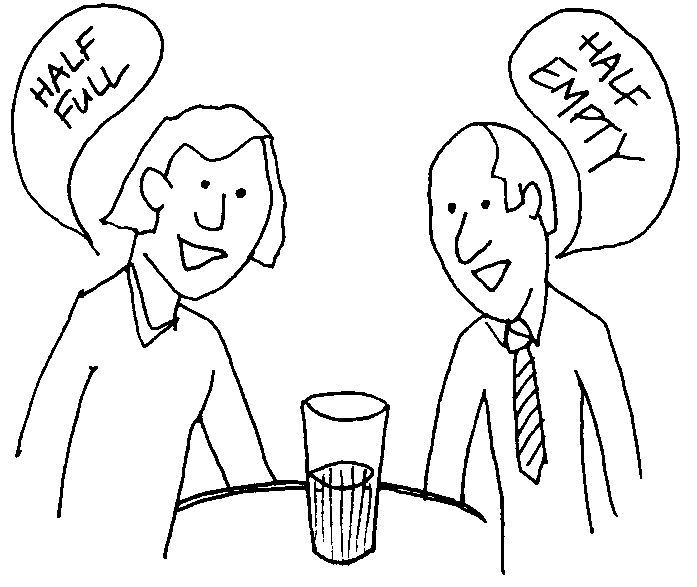
3 Simple Rules For Life


 Perceptions are a normal part of daily life. It is normal to have a perception of someone, something or a situation, but this perception is often judgmental. One tends to allow feelings, emotions and looks to affect the perception. Despite being a normal and inherent part of human psychology, perceptions can be highly problematic if left uncontrolled in the case of traders.
Perceptions are a normal part of daily life. It is normal to have a perception of someone, something or a situation, but this perception is often judgmental. One tends to allow feelings, emotions and looks to affect the perception. Despite being a normal and inherent part of human psychology, perceptions can be highly problematic if left uncontrolled in the case of traders.
A trader cannot allow perceptions to cloud his/her judgement and decisions. Perceptions can be deceiving and they thus need to be kept in check as they could lead to erroneous decisions.
In a perfect world, a trader will manage to be completely rational. He/she would be able to assess all facts so as to base decisions and choices on sound information and data. Such a perfect scenario would not allow emotions, perceptions and feelings to come into the picture. As a result the decision making process and the resultant decisions should be ideal. However this is an unreal scenario as we all know that this is not possible in a real world. This is what makes trading psychology so interesting, and yet so complicated and complex. However one should consider this in a positive way as it after all lies at the foundation of why the market and the life of a trader is so challenging and exciting.
The basic idea is to try to keep perceptions under control as much as possible. Despite all efforts though, even seasoned traders may find it hard to be veyr rational at times. One cannot forget that there is tension, pressure, emotion and various other aspects which come into play while a trader is trying to make up his/her mind about the best and the safest course of action. (more…)
“Trade what you see” is a common mantra among short-term traders who formulate their trade ideas from charts. But do we process information from charts in accurate and non-biased ways?
An interesting set of studies reported in the 2003 Journal of Behavioral Finance suggest that perceptual biases in what we see can skew our trading and investment decisions.
Specifically, when investors see a chart that has a salient high point, they are more likely to want to buy that stock. When the chart depicts a salient low point, they are more apt to sell. In the words of the authors, “expectations about future prices assimilated to extreme past prices.”
The authors found that, when a chart contained a highly noticeable high point, traders listed more favorable features of the stock; when the chart depicted a salient low, more negative aspects of the stock were emphasized. Their analyses suggest that charts affect investors by providing them with enhanced access to either positive or negative information about the stock. In other words, our processing of the chart creates a selective bias in retrieval, leading us to view shares in artificially positive or negative ways.
It isn’t too far from the authors’ finding to a broader psychological hypothesis that *any* highly salient feature of a trading situation may skew information retrieval, perception, and action. For instance, the salient information may be a recent large gain or loss; a dramatic market move; or a piece of news. Trading what we see might be dangerous for the same reason that it is dangerous to trade what we hear or what we feel.
When one facet of a situation becomes highly salient to us, we overweight it in our perception and information processing. Our ability to view the entire situation in perspective is compromised. What is most obvious in a chart–or in our minds–may not be an accurate reflection of underlying supply and demand in a marketplace.

 Don’t speculate unless you do it full time
Don’t speculate unless you do it full time
Take your losses swiftly and clearly; the first loss is the your easiest loss
Don’t trade too many securities; focus on a few investments that can be monitored carefully.


 It has long been observed, casually, that the trends of hemlines and stock prices appear to be in lock step. Skirt heights rose to mini-skirt brevity in the 1920’s and in the 1960’s, peaking with stock prices both times. Floor length fashions appeared in the 1930’s and 1970’s (the Maxi), bottoming with stock prices. It is not unreasonable to hypothesize that a rise in both hemlines and stock prices reflects a general increase in friskiness and daring among the population, and a decline in both, a decrease. Because skirt lengths have limits (the floor and the upper thigh, respectively), the reaching of a limit would imply that a maximum of positive or negative mood had been achieved
It has long been observed, casually, that the trends of hemlines and stock prices appear to be in lock step. Skirt heights rose to mini-skirt brevity in the 1920’s and in the 1960’s, peaking with stock prices both times. Floor length fashions appeared in the 1930’s and 1970’s (the Maxi), bottoming with stock prices. It is not unreasonable to hypothesize that a rise in both hemlines and stock prices reflects a general increase in friskiness and daring among the population, and a decline in both, a decrease. Because skirt lengths have limits (the floor and the upper thigh, respectively), the reaching of a limit would imply that a maximum of positive or negative mood had been achieved
A random person is pulled off the street and given $10,000 to trade. They have no prior experience which, on the bright side, means they have no bad habits, emotional baggage, or preconceived notions. Before trading they go through a five day crash course on market basics (order entry process, chart reading, pattern recognition, etc…). Suppose you are tasked with the responsibility of drafting a set of risk management rules which they are required to abide by. The objective is to make them survive as long as possible in the trading arena so they can learn as much as possible through first-hand experience.
What types of rules would you set?
The ideal approach of course is to structure a set of rules which makes it as difficult as possible to blow up the account while still leaving them open to accumulating profits. The goal isn’t so much helping them capture large gains as much as it is helping them survive. After learning how to survive, then they can modify their approach to being more aggressive and seeking larger gains.
Here are two of my top rules: (more…)